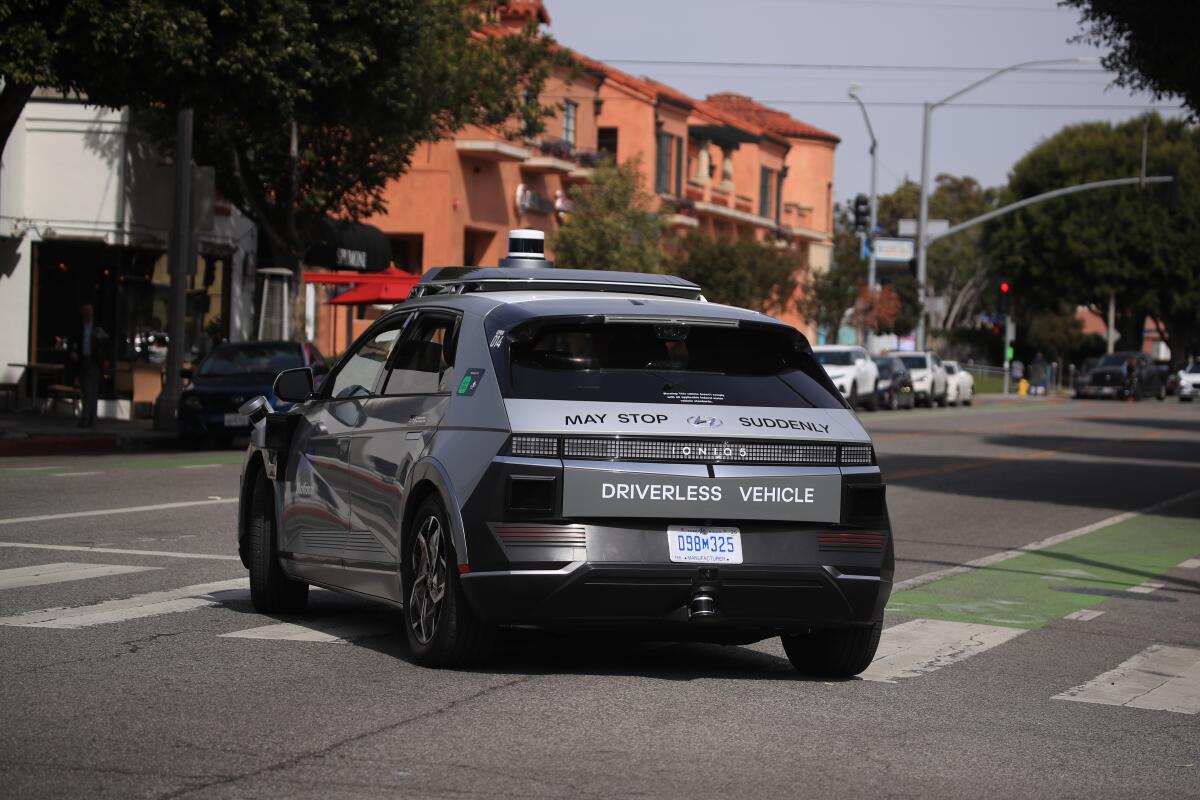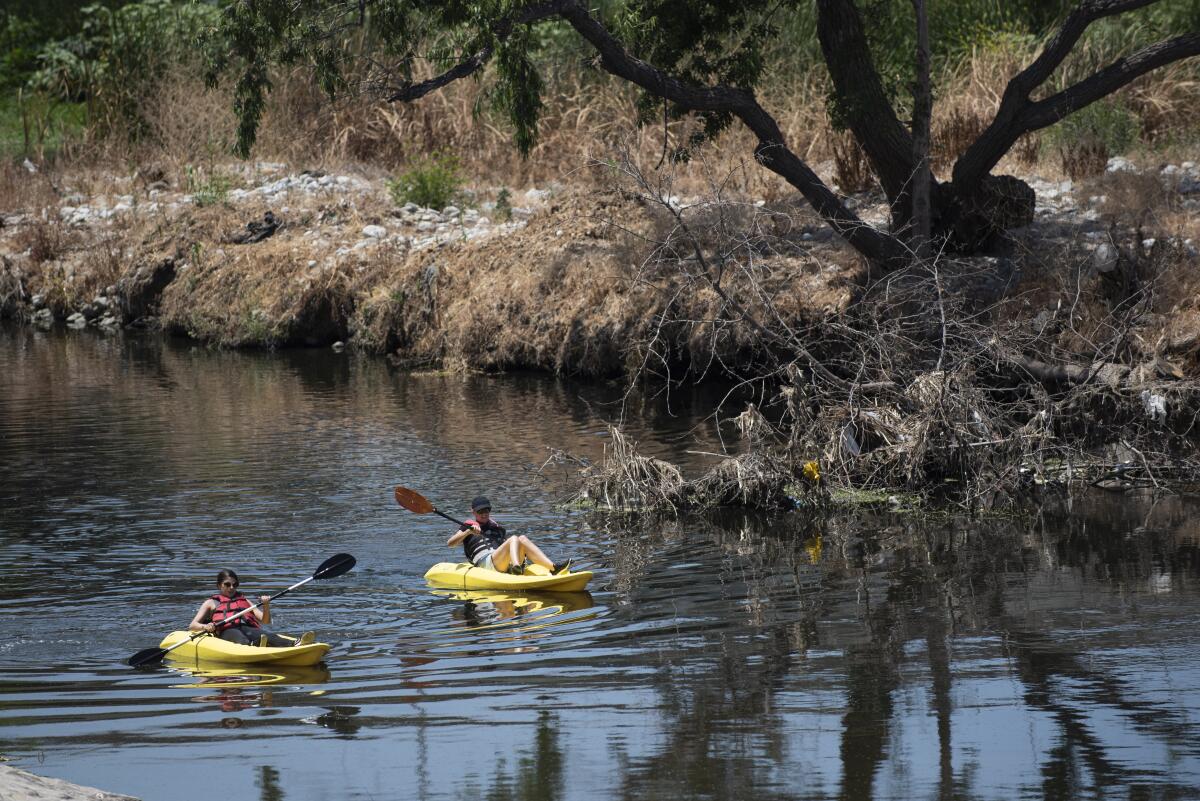‘Don’t make us the guinea pigs’: California cities want to pump the brakes on driverless taxis

Good morning, and welcome to the Essential California newsletter. It’s Friday, June 23.
Californians could start seeing more driverless taxis rolling on city streets in the near future, but many officials aren’t hailing that as a good thing.
For the record:
4:13 p.m. June 26, 2023An earlier version of this newsletter combined crash data for advanced driver assistance systems with automated driving systems. Available NHTSA crash data show five crashes involving autonomous vehicles that caused moderate and serious injuries and no human fatalities, while vehicles equipped with advanced driver assistance systems were involved in 40 crashes with moderate and serious injuries and 22 fatal crashes.
The road to autonomous vehicles has been ramping up in recent years, with both tech companies and automakers framing them as a safer, more equitable form of driving. Driverless taxis are picking up passengers in San Francisco, and companies including Waymo, Cruise and Motional are testing their technology in L.A. and Santa Monica.
But some elected leaders and transportation officials want to slow their rollouts on city streets. As Russ Mitchell, who covers the auto industry for The Times, reported this week:
The robotaxi industry is being allowed to move too fast and break things, these officials say, putting more robotaxis on public streets even as they prove inept at dealing with firetrucks, ambulances and police cars.
Earlier this year, the San Francisco Chronicle mapped more than 90 incidents documented by the local transit agency “where self-driving taxis created mayhem on city streets — disrupting traffic ... transit and emergency responders.”
The city’s Fire Department has noted nearly 40 incidents since the start of the year, including instances of the taxis ignoring road warning signs and running through caution tape; blocking a firetruck’s route to a burning building; and parking on top of fire hoses in an active fire scene.
While no human fatalities caused by the taxis have been reported in San Francisco, officials there have sounded the alarm about the risks of a faulty taxi obstructing traffic and blocking first responders’ path to a life-or-death emergency.
Autonomous vehicles are also creating hazards for other road users. California’s DMV has logged 612 crash reports between 2014 and June 16, 2023, that involved autonomous vehicles of any kind (not just taxis). Available crash data from the National Highway Traffic Safety Administration, show five crashes involving autonomous vehicles that caused moderate and serious injuries and no human fatalities, while vehicles equipped with advanced driver assistance systems were involved in 40 crashes with moderate and serious injuries and 22 fatal crashes.
“Interacting properly with emergency personnel is important to us, which is why we maintain an open line of communication with first responders to receive feedback and discuss specific incidents to improve our response,” Hannah Lindow, a spokesperson for Cruise, told Mitchell.
City officials have also cited a lack of transparency from the tech companies regarding collision reports, safety performance and how their staff respond to emergencies. The opacity stems from a court-approved deal backed by the Department of Motor Vehicles, on the grounds of shielding company trade secrets.
That’s one reason some state and municipal lawmakers have expressed a lack of confidence in the DMV’s ability to properly regulate the technology.
City leaders in San Francisco and beyond are calling out state regulators, saying they’ve been too lenient on autonomous taxi companies who are still working out kinks in their technology as it drives around public spaces.
“We’re saying, don’t give them everything they want until these things are proven,” San Francisco County Supervisor Aaron Peskin told Mitchell. “Don’t make us the guinea pigs.”
One of those regulatory groups — the California Public Utilities Commission — is slated to vote next week on allowing Waymo and Cruise to expand their services in the state. The commission states that their operation “is not anticipated to result in significant safety risks.”
Transportation officials from L.A. and Santa Monica have both called for the commission to mandate an incremental rollout, which the companies oppose. Mitchell summed up why:
Robotaxi companies have spent enormous sums developing expensive artificial intelligence technology and want a return on investment.
New technology always brings disruption, but will cities put up with that in the short term for the safer, less-congested future the tech and auto industries are promising?
I’ll throw it back to an earlier conversation I had about autonomous vehicles with tech historian Peter Norton, who said we should be wary of any industry that claims it will solve the problems its own products created.
“Tech companies and automakers should not be confused with policymakers,” he told me. “We have made that confusion very pervasive, and I’m not that optimistic that we’ll resist that successfully.”
And now, here’s what’s happening across California:
Note: Some of the sites we link to may limit the number of stories you can access without subscribing.
L.A. STORIES
I’ve passed the row of concrete pillars in Eagle Rock dozens of times, but had no idea they had a local nickname: “Pillarhenge.” The landmark (or eyesore, depending on whom you ask) is the skeleton of a housing development that was abandoned during the 2008 recession. But now the property is finally poised for development, with plans for a four-story, mixed-use complex — though some residents were pushing for a public park. Los Angeles Times
You can kayak the L.A. River, though its mucky water and blighted banks don’t make for a convincingly natural experience. There’s a multibillion-dollar plan to restore and revitalize the urbanized waterway, though some local conservationists are frustrated by its slow pace. Los Angeles Times

POLITICS AND GOVERNMENT
An Ojai City Council member lost her home and is struggling to find a new place to live in her district. As she fights to keep her council seat, advocates point to her plight as indicative of the state’s affordable housing crisis. CalMatters
Dozens of graduate students at UC San Diego could face disciplinary action, including possible expulsion, for taking part in a campus demonstration last month. The student workers, part of United Auto Workers 2865, interrupted an alumni awards ceremony to accuse administrators of violating a union contract brokered after weeks of protest across the UC system in late 2022. San Diego Union-Tribune
CRIME, COURTS AND POLICING
L.A. City Atty. Hydee Feldstein Soto is calling on California lawmakers to weaken the state’s public records law, sparking condemnation from civil rights advocates. That follows an activist coalition’s publication of Los Angeles police officers’ names, photos, badge numbers and other work-related information. The group says it obtained the data through a public records request, which inadvertently included officers in sensitive undercover assignments, according to city officials. Los Angeles Times
Both CalPERS and CalSTRS — the two largest public pension systems in the nation — have been hacked, the agencies reported this week. CalPERS officials said hackers swiped roughly 769,000 retirees’ and beneficiaries’ names, Social Security numbers, birth dates and more. CalSTRS has not provided details on how many people were affected. The Sacramento Bee
Support our journalism
HEALTH AND THE ENVIRONMENT
Three natural gas-fired power plants along SoCal’s coast were set to be shut down in 2020. But after rolling blackouts raised concerns about the state’s power supply, the plants were granted a three-year extension. Now regulators are set to vote on another three-year extension. In his Boiling Point newsletter, my colleague Sammy Roth calls the saga “the latest illustration of the difficult balancing act California faces in its quest to phase out planet-warming fossil fuels and show the rest of the world that addressing the climate crisis is possible.” Los Angeles Times
A tiny creature represents a big find in San José. The Santa Cruz kangaroo rat — considered “critically imperiled” by the state — was spotted in a natural preserve for the first time in 75 years. Researchers hope the discovery will help them better protect the rare species (which, despite its name, is closer to a gopher or chipmunk). San Francisco Chronicle
Free online games
Get our free daily crossword puzzle, sudoku, word search and arcade games in our new game center at latimes.com/games.
AND FINALLY
Today’s California landmark is from Judith Skartvedt of Cambria: the photogenic Moonstone Beach.

Judith writes:
This photo was taken in Cambria at a park that’s popular for watching the sun go down. It was taken after the many recent weeks of rainfall and Santa Rosa Creek had become a roaring river!
What are California’s essential landmarks? Fill out this form to send us your photos of a special spot in California — natural or human-made. Tell us why it’s interesting and what makes it a symbol of life in the Golden State. Please be sure to include only photos taken directly by you. Your submission could be featured in a future edition of the newsletter.
Please let us know what we can do to make this newsletter more useful to you. Send comments to [email protected].
Sign up for Essential California
The most important California stories and recommendations in your inbox every morning.
You may occasionally receive promotional content from the Los Angeles Times.




